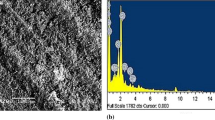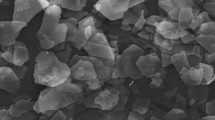Abstract
The improved performance of polymers and their composites in industrial and structural applications by the addition of particulate fillers has shown a great promise and so has lately been the subject of considerable interest. In the present study, titanium oxide (TiO2) particles of average size 75 μm are reinforced in unsaturated polyester resin to prepare particulate filled composites of three different compositions (with 0, 10, and 20 wt% of TiO2). Dry sliding wear trials are conducted following design of experiments (DOE) using a standard pin-on-disc test set-up. Significant control factors predominantly influencing the wear rate are identified. Effect of TiO2 content on the wear rate of polyester composites under different test conditions is studied. An Artificial Neural Networks (ANN) approach taking into account training and test procedure to predict the dependence of wear behavior on various control factors is implemented. This technique helps in saving time and resources for large number of experimental trials and predicts the wear response of TiO2- polyester composites beyond the experimental domain.
Similar content being viewed by others
Explore related subjects
Discover the latest articles, news and stories from top researchers in related subjects.Avoid common mistakes on your manuscript.
Introduction
It has been observed that by incorporating hard filler particles into polymer based composites, synergistic effects may be achieved in the form of higher modulus and reduced material cost [1–3]. The inclusion of such particulate fillers into polymers for commercial applications is primarily aimed at the cost reduction and stiffness improvement [4, 5]. However, study of the effect of such filler addition is necessary to ensure that the mechanical properties of the composites are not affected adversely by such addition. Available references suggest a large number of materials being used as fillers in polymers [6–9]. Various kinds of polymers and polymer–matrix composites reinforced with metal particles have a wide range of industrial applications such as heaters, electrodes [10], composites with thermal durability at high temperature [11], etc. Ceramic filled polymer composites have also been the subject of extensive research in recent years and consequently, a number of reports are available on the use of ceramics such as Al2O3, SiC etc. as particulate fillers [12–15]. But the potential of titanium oxide as a filler material in polyester matrix has not been reported so far. This work investigates and analyses the sliding wear response of these polyester composites filled with micro-sized TiO2 particles using artificial neural networks (ANN) which is inspired by the biological neural system and has been used to solve a wide variety of problems in diverse fields [16, 17].
Experimental details
Sliding wear test
Wear tests are carried out in a pin-on-disc type friction and wear monitoring test rig as per ASTM G 99. The counter body is a disc made of hardened ground steel (EN-32, hardness 72 HRC, surface roughness 0.6 μm Ra). The specimen is held stationary and the disc is rotated while a normal force is applied through a lever mechanism. A series of tests are conducted with three sliding velocities of 165, 250, and 335 cm/s under three different normal loadings of 5, 10 and 15 N (Table 1). The material loss from the composite surface is measured using a precision electronic balance with accuracy ±0.1 mg and the specific wear rate (mm3/ N-m) is then expressed on ‘volume loss’ basis as:
Where Δm is the mass loss in the test duration (gm), ρ is the density of the composite (gm/mm3), t is the test duration (sec), V s is the sliding velocity (m/sec), and Fn is the average normal load (Newton). The specific wear rate is defined as the volume loss of the specimen per unit sliding distance per unit applied normal load.
Results and discussion
Dry sliding wear test results
The specific wear rates obtained for all the 9 test runs along with the corresponding S/N ratio are presented in Table 2. From this table, the overall mean for the S/N ratio of the wear rate is found to be −2.984 dB. This is done using the software MINITAB 14 specifically used for design of experiment applications. The S/N ratio response analysis shows that among all the factors, sliding velocity is the most significant factor followed by filler content and normal load while the sliding distance has the least or almost no significance on wear rate of the particulate filled composites under this investigation. The analysis of the results leads to the conclusion that factor combination of A1, B3, C3 gives the minimum specific wear rate.
Analysis using ANN
Wear process is considered as a non-linear problem with respect to its variables: either materials or operating conditions. To obtain minimum wear rate, appropriate combinations of operating parameters have to be planned. In this work, a statistical method, responding to the constraints, is implemented to correlate the operating parameters. This methodology is based on ANN, which is a technique that involves database training to predict input-output evolutions. In the present analysis, the sliding velocity, filler content, normal load and sliding distance are taken as the four input parameters. As already described, each of these parameters is characterized by one neuron and consequently the input layer in the ANN structure has four neurons. Different ANN structures with varying number of neurons in the hidden layer are tested at constant cycles, learning rate, error tolerance, momentum parameter, noise factor and slope parameter. Based on least error criterion, one structure, shown in Table 3, is selected for training of the input-output data. A software package NEURALNET for neural computing using back propagation algorithm is used as the prediction tool for specific wear rate of the composite samples under various test conditions. The three-layer neural network having an input layer (I) with four input nodes, a hidden layer(H) with twelve neurons and an output layer (O) with one output node used in this work is shown in Fig. 1.
Table 3 presents a comparison between the experimental and the ANN predicted results. The errors associated in each test run with respect to the experimental results are also given in the table. It is observed that the error in ANN prediction lies in the range of 0–8% which establishes the validity of the neural computation. The simulated specific wear rates indicating the effect of varying sliding velocity is presented in Fig. 2. It is interesting to note that the specific wear rate increases almost exponentially with the increase in sliding velocity.
Conclusions
Dry sliding wear characteristics of these composites can be experimented following a design-of-experiment approach. This study reveals that TiO2 possesses good filler characteristics as it improves the sliding wear resistance of the composite. ANN technique is successfully applied in this investigation to predict and simulate the wear response of the composites under various test conditions within and beyond the experimental domain. The predictions of wear rates as functions of filler content and testing conditions thus prove a remarkable capability of well-trained neural networks for modeling concern.
References
Pukanszky B (1995) Particulate filled polypropylene: Structure and properties. In: Karger-Kocsis J (ed) Polypropylene: structure, blends and composites. Chapman & Hall, London
Acosta JL, Morales E, Ojeda MC, Linares A (1986) Effect of addition of sepiolite on the mechanical properties of glass fiber reinforced polypropylene. Angew Makromol Chem 138:103–10
Gregory SW, Freudenberg KD, Bhimaraj P, Schadler LS (2003) A study on the friction and wear behavior of PTFE filled with alumina nanoparticles. Wear 254:573–580
Rothon RN (1997) Mineral fillers in thermoplastics: filler manufacture. Adhesion 64:87–109
Rothon RN (1999) Mineral fillers in thermoplastics: filler manufacture and characterization. Adv Polym Sci 139:67–107
Katz HS, Mileski JV (1987) Handbook of fillers for plastics, A Von Nostrand Reinhold Book
Zhenyu J, Lada AG, Alois KS, Klaus F, Zhong Z (2008) Study on friction and wear behavior of polyphenylene sulfide composites reinforced by short carbon fibers and sub-micro TiO2 particles. Compos Sci Technol 68:734–742
Chang L, Zhang Z, Breidt C, Friedrich K (2005) Tribological properties of epoxy nanocomposites I. Enhancement of the wear resistance by nano-TiO2 particles. Wear 258:141–148
Satapathy A, Patnaik A (2008) Analysis of dry sliding wear behavior of red mud filled polyester composites using the Taguchi method. J Reinf Plast Compos. doi:10.1177/0731684408092453
Jang BZ (1994) Advanced polymer composites: principles and applications. ASM International
Jung-il K, Kang PH, Nho YC (2004) Positive temperature coefficient behavior of polymer composites having a high melting temperature. J Appl Polym Sci 92:394–401
Patnaik A, Satapathy A, Mahapatra SS, Dash RR (2009) Modeling and prediction of erosion response of glass reinforced polyester-flyash composites. J Reinf Plast Compos 28:513–536
Patnaik A, Satapathy A, Mahapatra SS, Dash RR (2008) Parametric optimization of erosion wear of polyester-GF-alumina hybrid composites using Taguchi method. J Reinf Plast Compos 27:1039–1058
Patnaik A, Satapathy A, Mahapatra SS, Dash RR (2008) Implementation of Taguchi design for erosion of fiber reinforced polyester composite systems with SiC filler. J Reinf Plast Compos 27:1093–1111
Patnaik A, Satapathy A, Mahapatra SS, Dash RR (2008) Erosive Wear Assesment of Glass Reinforced Polyester-Flyash Composites using Taguchi Method. International Polymer Processing, XXIII, pp 192–199
Zhang Z, Friedrich K (2003) Artificial neural networks applied to polymer composites: a review. Compos Sci Technol 63(14):2029–44
Kadi HE (2006) Modeling the mechanical behavior of fiber-reinforced polymeric composite materials using artificial neural networks—A review. Compos Struct 73(1):1–23
Author information
Authors and Affiliations
Corresponding author
Rights and permissions
About this article
Cite this article
Satapathy, A., Tarkes, D.P. & Nayak, N.B. Wear response prediction of TiO2-polyester composites using neural networks. Int J Plast Technol 14 (Suppl 1), 24–29 (2010). https://doi.org/10.1007/s12588-010-0004-4
Received:
Accepted:
Published:
Issue Date:
DOI: https://doi.org/10.1007/s12588-010-0004-4






